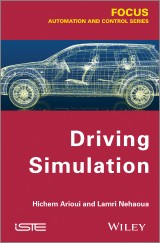Details

Driving Simulation
1. Aufl.
|
139,99 € |
|
| Verlag: | Wiley |
| Format: | EPUB |
| Veröffentl.: | 02.12.2013 |
| ISBN/EAN: | 9781118648643 |
| Sprache: | englisch |
| Anzahl Seiten: | 217 |
DRM-geschütztes eBook, Sie benötigen z.B. Adobe Digital Editions und eine Adobe ID zum Lesen.
Beschreibungen
Passive and active safety systems (ABS, ESP, safety belts, airbags, etc.) represent a major advance in terms of safety in motoring. They are increasingly developed and installed in cars and are beginning to appear in twowheelers. It is clear that these systems have proven<br />efficient, although there is no information about their actual operation by current users. The authors of this book present a state of the art on safety systems and assistance to driving and their two-wheeled counterparts. The main components constituting a driving simulator are described, followed by a classification of robotic architectures. Then, a literature review on driving simulators and two-wheeled vehicles is presented. The aim of the book is to point out the differences of perspectives between motor vehicles and motorcycles to identify relevant indicators to help in choosing the mechanical architecture of the motorcycle simulator and appropriate controls.<br /> <p>Contents</p> <p>1. Driving Simulation.<br />2. Architecture of Driving Simulators.<br />3. Dynamics of Two-Wheeled Vehicles.<br />4. Two-Wheeled Riding Simulator: From Design to Control.</p>
<p><b>ACKNOWLEDGMENTS ix</b></p> <p><b>INTRODUCTION xi</b></p> <p><b>CHAPTER 1. DRIVING SIMULATION 1</b></p> <p>1.1. Objectives of driving simulation 1</p> <p>1.2. A short history of driving simulators 3</p> <p>1.2.1. Fixed-base platforms 3</p> <p>1.2.2. Platforms with a serial structure 5</p> <p>1.2.3. Platforms with parallel structure 5</p> <p>1.2.4. Hybrid structured platforms 10</p> <p>1.2.5. “Low-cost” generation 14</p> <p>1.3. Driving simulation objectives 16</p> <p><b>CHAPTER 2. ARCHITECTURE OF DRIVING SIMULATORS 19</b></p> <p>2.1. Architecture of driving simulators 19</p> <p>2.2. Motion cueing and haptic feedback 26</p> <p>2.2.1. The human motion perception system 27</p> <p>2.2.2. Mathematical description 30</p> <p>2.2.3. Motion cueing algorithm 33</p> <p>2.3. The evolution of simulators: from the automobile to the motorcycle 48</p> <p>2.3.1. Honda simulators 48</p> <p>2.3.2. Tokyo university simulator 51</p> <p>2.3.3. MORIS simulator 52</p> <p>2.3.4. SafeBike simulator 53</p> <p>2.3.5. Bicycle simulator – Kaist 55</p> <p>2.3.6. Discussion 55</p> <p><b>CHAPTER 3. DYNAMICS OF TWO-WHEELED VEHICLES 57</b></p> <p>3.1. Modeling aspect 57</p> <p>3.1.1. Vehicle motion 59</p> <p>3.1.2. Road–tire interface 60</p> <p>3.1.3. Direction system 65</p> <p>3.1.4. Suspensions 67</p> <p>3.1.5. Motorization and traction chain 67</p> <p>3.2. The literature on existing models 69</p> <p>3.2.1. Models of the automobile 69</p> <p>3.2.2. Two-wheeled vehicle models 71</p> <p>3.3. Dynamic behavior of automobiles 77</p> <p>3.4. Dynamic behavior of two-wheeled vehicles 77</p> <p>3.5. Summary 82</p> <p><b>CHAPTER 4. TWO-WHEELED RIDING SIMULATOR: FROM DESIGN TO CONTROL 85</b></p> <p>4.1. Introduction 85</p> <p>4.2. The design and mechanical aspects of the simulator 86</p> <p>4.3. The mechatronics of the simulator 92</p> <p>4.3.1. Description of the simulation loop 92</p> <p>4.3.2. Platform instrumentation 94</p> <p>4.3.3. Sequencing and synchronization 99</p> <p>4.4. Specification of the simulator 101</p> <p>4.4.1. Inverse kinematic of the simulator platform 101</p> <p>4.4.2. Dynamic modeling of the platform 107</p> <p>4.4.3. Identification 109</p> <p>4.5. Multi-sensory integration: washout and force feedback 116</p> <p>4.5.1. Localization of the washout 116</p> <p><b>BIBLIOGRAPHY 125</b></p> <p><b>INDEX 135</b></p>
<p><strong>Hichem Arioui</strong> is lecturare at the University of Evry Val d'Essone, Evry, France. <p><strong>Lamri Nehaoua</strong> is a Postdoctoral Research fellow at the Laboratory IBIS of the University Evry Val d'Essone, Evry, France.
Diese Produkte könnten Sie auch interessieren:

Turbulent Drag Reduction by Surfactant Additives

von: Feng-Chen Li, Bo Yu, Jin-Jia Wei, Yasuo Kawaguchi

156,99 €

Turbulent Drag Reduction by Surfactant Additives

von: Feng-Chen Li, Bo Yu, Jin-Jia Wei, Yasuo Kawaguchi

156,99 €














